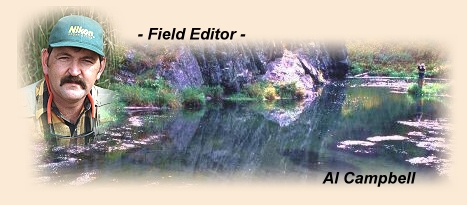|
If you were a bird, and you flew roughly ten
miles north by northeast from the small spring
that is the birthplace of Castle Creek; you'd
find another spring that generates the first
flows of the south fork of Rapid Creek. Like
all the streams in the Black Hills, Rapid Creek
starts as a spring creek and flows outward from
the center of the Black Hills toward the prairie.
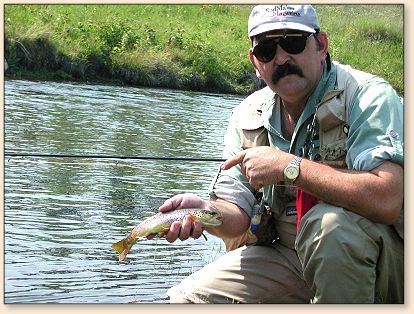
From its beginnings to its junction with the North
Fork of Rapid Creek, the South Fork runs parallel
to Forest Service road 231; so access is as easy
as pulling off the side of the road. An occasional
beaver dam temporarily blocks this tumbling stream
loaded with feisty brook trout. Although the
occasional brown trout you will catch in the upper
reaches of Rapid Creek are larger than their brookie
cousins, they can't match the brook trout in color
or enthusiasm.
The North Fork of Rapid Creek starts near and flows
parallel to Forest Service road 17 on its south by
southeast journey to its junction with the South Fork
near the town of Rochford. Like the South Fork, this
branch of Rapid Creek is alive with hungry brookies
and occasional brown trout. Both branches of Rapid
Creek have robust aquatic insect populations that
are augmented in late summer by hoppers and flying
ants. If you don't mind modest sized fish that are
full of color and eager to inhale a fly, this is a
good place to start any Black Hills fishing vacation.

From the town of Rochford, downstream to Pactola Reservoir
(a distance of about 20 miles), Rapid Creek is joined
by Castle Creek and Slate Creek. Access to this portion
of the stream is provided by Forest Service road 231 and
a walk-in trail that starts near the old mining town of
Mystic and parallels the creek to the town of Silver
City. Brown trout and planted rainbow trout are the
common catches in this area.
Like the lower reaches of Castle Creek, this section
of stream is slightly colored by runoff from old mines
and iron bogs. The tainted water has a greater impact
on the aquatic insect populations than it does on the
trout populations, but it doesn't hurt the fish
population nearly as bad as bait fishing and
over-harvesting does. Unfortunately, the fact that
large rainbow trout are stocked in this area is a
strong invitation to bait fishermen looking to add
some large fish to their stringers. By mid-summer,
the walk-in area near Silver City has been hard hit
and fishing gets tough.
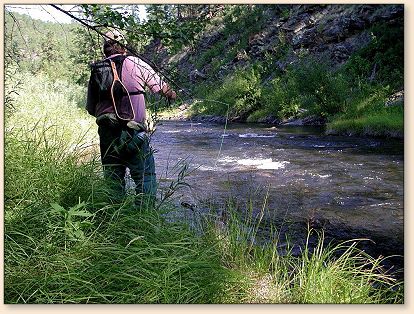
Pactola Lake offers fishing for rainbow trout, lake
trout to 20 plus pounds (the lake trout record has
been broken already twice this summer with fish near
25 pounds) and some very large brown trout up to 20
pounds or more. It also has healthy populations of
largemouth bass, crappie and perch as well as an
occasional kokanee salmon. Trolling hardware deep
behind a boat produces the best catches for large
browns and lake trout in lake, but evening fly-fishing
from a boat can be productive for rainbows.
The first three miles of stream below Pactola Reservoir
is managed as a trophy trout area that is protected by
catch and release regulations and artificial lures are
the only legal means for catching fish in this area.
The water is cold and clean all year and some of the
trout grow to large sizes. Unfortunately, there has
been some problems with poaching in this area, and
game wardens are kept busy patrolling for bait fishermen.
Despite the poaching problems, this continues to be a
true trophy waterway, and some very healthy brown trout
can be caught if you know how to fish for them.
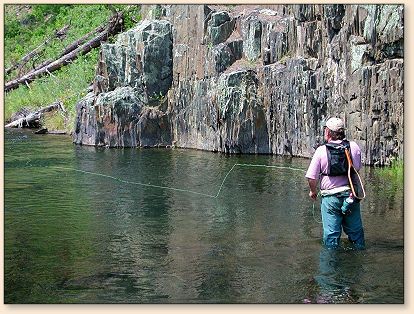
Access to these three miles of water is by foot only,
but there are some easy trails to follow. Since the
water is cold, the insects are usually fairly small
with midges being the predominant species of insect.
Long, accurate casts and careful approaches to the
stream are the rule if you want a chance to hook one
of these trout. If you are a beginner, this isn't
the type of water that will bolster your confidence.
Some very capable fishermen have left this area of
Rapid Creek feeling humbled to the core; but if you
can master her secrets, Rapid Creek will deliver some
true treasures in this three-mile section of stream.
From the church camp three miles below Pactola Dam to
the town of Rapid City (about 20 miles) access to the
stream is limited to hiking and very few public access
points. Where the road (SD Highway 44) does parallel
the creek, private dwellings line the creek banks.
Anyone willing to take a long hike will be rewarded
with good fishing, but the canyon is steep and narrow
and the hike in can be rough to say the least. A
minor warning; rattlesnakes are abundant in several
areas of this portion of the stream where access is
gained by hiking down steep, rocky hillsides.
Some of the most productive fishing on Rapid Creek
can be found in and immediately upstream from the
town of Rapid City. Because of the urban setting,
this part of the stream is often ignored and the
fish see less pressure than other parts Rapid Creek.
Except for Canyon Lake and the area immediately
upstream from the lake, the creek sees little fishing
pressure during the summer months.
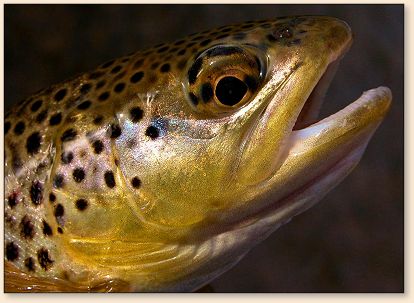
Special regulations to protect brown trout spawning
populations apply to the stream near Canyon Lake.
Like the area immediately below Pactola Reservoir,
there is a catch and release area in Rapid City that
is limited to artificial lures and zero kill. One
might expect that fishermen would key in on this
special part of the stream but it hasn't happened
yet. Part of the reason for that is that the
special regulation area is in the golf course,
but the urban environment seems to deter fishermen
too.
In 1972, Rapid Creek flooded killing several hundred
people. After the flood, the flood plane through town
was dedicated to the victims as a memorial park.
Access to Rapid Creek all the way through the town
of Rapid City is public and easy. A bike and walking
path follows the creek through town from one end to
the other. I have never found any other stream more
accessible to the public and so under-fished.
Caddisflies, mayflies, stoneflies and midges in
abundance and variety are the mainstay of the
trout diet in this area.
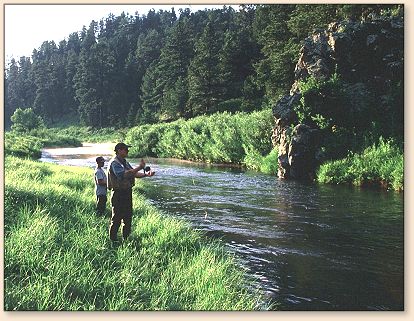
Since the reservoirs upstream are dedicated to
providing summer water for irrigation, summer
flows are usually a little high, but there is
never a concern for the creek going dry. During
drought years like we have had recently, Rapid
Creek has been a reliable stream with predictable
flows and hatches. It's also a good place to snag
a few evening hours of fishing after a tough day
at work. Winter fishing in town can be spectacular
while the upper reaches of the creek are locked
in ice.
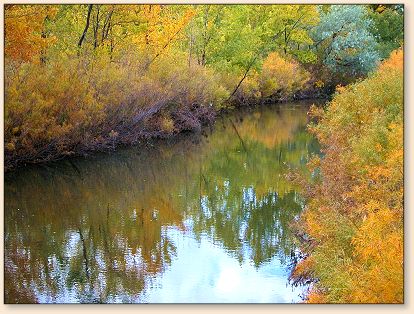
Downstream from Rapid City, Rapid Creek flows through
private land and is largely de-watered for irrigation
during the summer. A few large trout can be caught
if you can get permission to cross private land, but
the stream is more suitable to catfish than trout in
this area. If you do manage to gain permission to
fish this portion of the stream, you'll find some
large trout that rarely see a fly, so fishing could
be pretty good.
The most important aspect of Rapid Creek is that it
is close to where I live. I can be on the stream in
less than five minutes if I want to fish in town.
It is truly my home water and one I know very well.
I have fished every riffle and pool from one end of
Rapid City to the other, and most of the creek
upstream from town. There is a reason that several
stretches of this stream (including the part that
runs through Rapid City) are listed as a blue ribbon
trout stream. I invite you to explore that reason
for yourself.
~ AC
|
